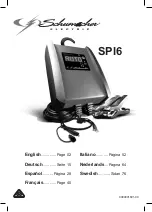
3. CONNECTION
Connect the crocodile clips to the battery in the following order:
A) Connect the positive charging lead (RED) to the positive terminal
post of the battery (marked P or +).
B) Connect the negative lead (BLACK) to the negative post of the
battery (marked N or -).
It is important to ensure that both crocodile clips are making good
contact with their respective terminal posts.
4. CHARGING
Insert the 13Amp plug into the mains supply (230 Volts AC only). Your
Battery Charger should now be charging and the power LED (Red) and
the charging LED (Yellow) on the front of the charger will be lit.
When a flat battery is initially connected to the Battery Charger the full
lamp should not be lit. When the battery is fully charged the full LED
(Green) will be lit.
N.B.If you have not connected the crocodile clips to the battery when
you turn on the mains power the ‘full’ lamp will light up. Similarly, if you
disconnect the clips form the battery, without switching off the mains
power, the lamp will stay lit. THIS IS NOT A FAULT.If you now connect
the clips to a battery the ‘full’ lamp will go out, unless the battery is fully
charged. PLEASE NOTE HOWEVER FOR REASONS OF SAFETY YOU
SHOULD ALWAYS CONNECT AND DISCONNECT THE CROCODILE
CLIPS TO THE BATTERY WITH THE MAINS POWER OFF.
5. ELECTROLYTE
Regularly check the specific gravity of the liquid, using a hydrometer,
until a reading of “FULLY CHARGED” or 1.250 is reached. A charging
time of no more than 10 hours is recommended for batteries of 34-45
ampere hour’s capacity.
6. WHEN THE CHARGING IS COMPLETE
Switch off the mains supply, unplug the charger, and disconnect the
leads from the battery posts. Inspect the liquid levels in each cell and
top up if necessary, using the correct fluid. Now replace the caps. Any
surplus fluid around the cell tops should be wiped off (this should be
done with extreme care as it may be acidic).
If the battery has been removed for charging, replace it and reconnect
the cables.
CAR BATTERY MAINTENANCE
It is essential to keep your battery regularly charged up throughout the year,
especially during the winter months.
In the winter the effectiveness of your car battery is reduced by the cold. Oil
is thick engines are difficult to start and the heater, windscreen wipers and
lights are all draining power. It is at this time that batteries have to be at
peak power. If your battery is not regularly maintained and kept fully
charged, it can cause problems and a possible breakdown.
Listed are some helpful hints on how to keep your battery healthy in
conjunction with your A1204/A1206S Battery Charger.
FAULTY CELLS
Batteries are usually made with six cells. One of these cells can deteriorate
or get damaged. If after several hours charging your battery is still flat, you
should test the battery. Take hydrometer readings form each cell in the
battery. If one reading is lower than the others this could indicate a faulty
cell. If necessary, get an Auto-Electrician to check your battery. One faulty
cell is enough to ruin your battery. It is pointless to continue using it and you
would be better getting a new one.
CARE
Sometimes the battery may appear flat, but this could simply be dirty or
loose connections on your battery terminals. It is important to maintain the
leads on a regular basis. Do this by removing the leads from the battery,
cleaning the inside of each connector and the terminal posts on the battery.
Smear the terminal posts with any of the readily available gels that one can
get for this purpose. Replace the connectors and tighten firmly.
It is essential to keep the electrolyte level above the plates. However, you
should not overfill it, as the electrolyte is strongly acidic.
When topping up DO NOT USE TAP WATER.Always use distilled or ionised
water
It is important to keep the acid level topped up, if necessary have it checked
by your garage.
Page 5






















